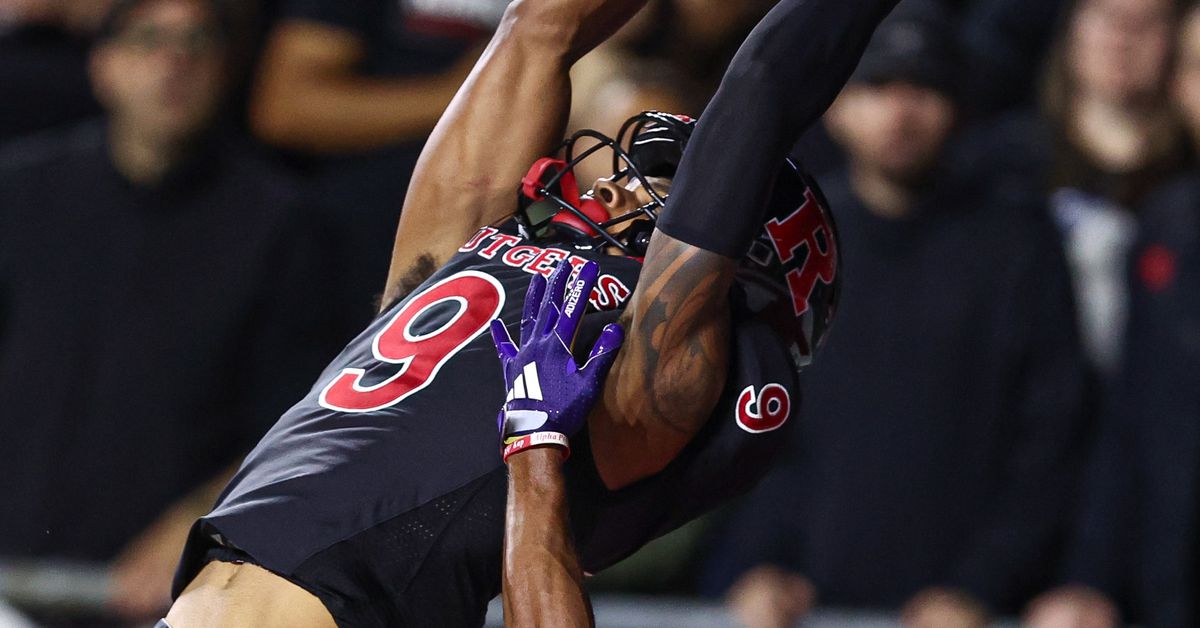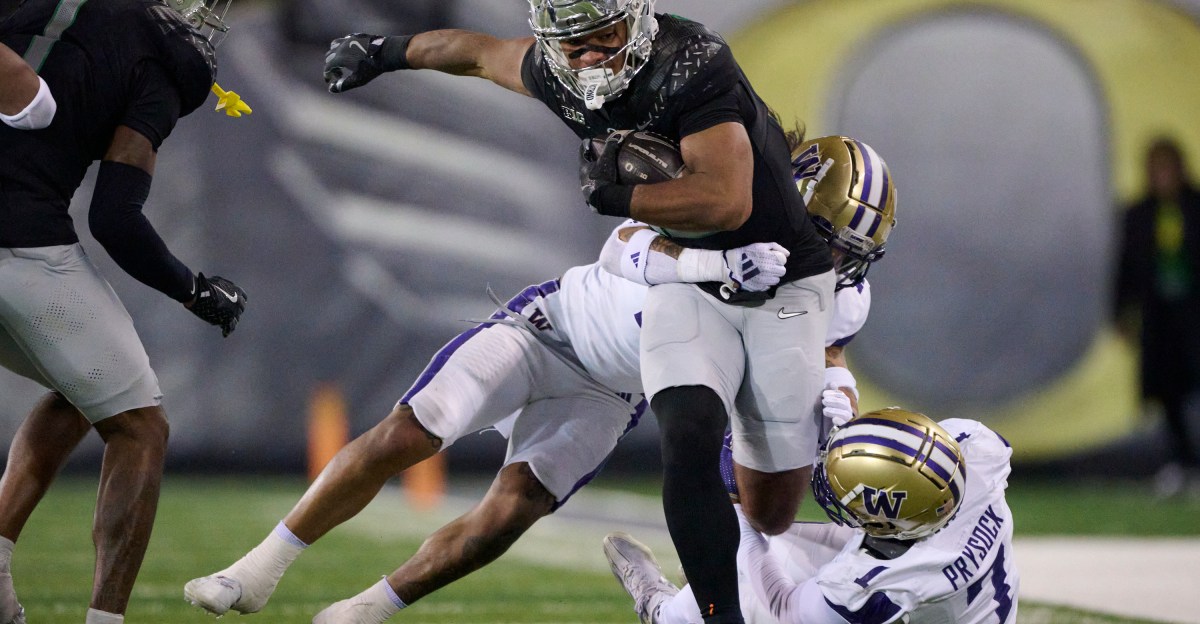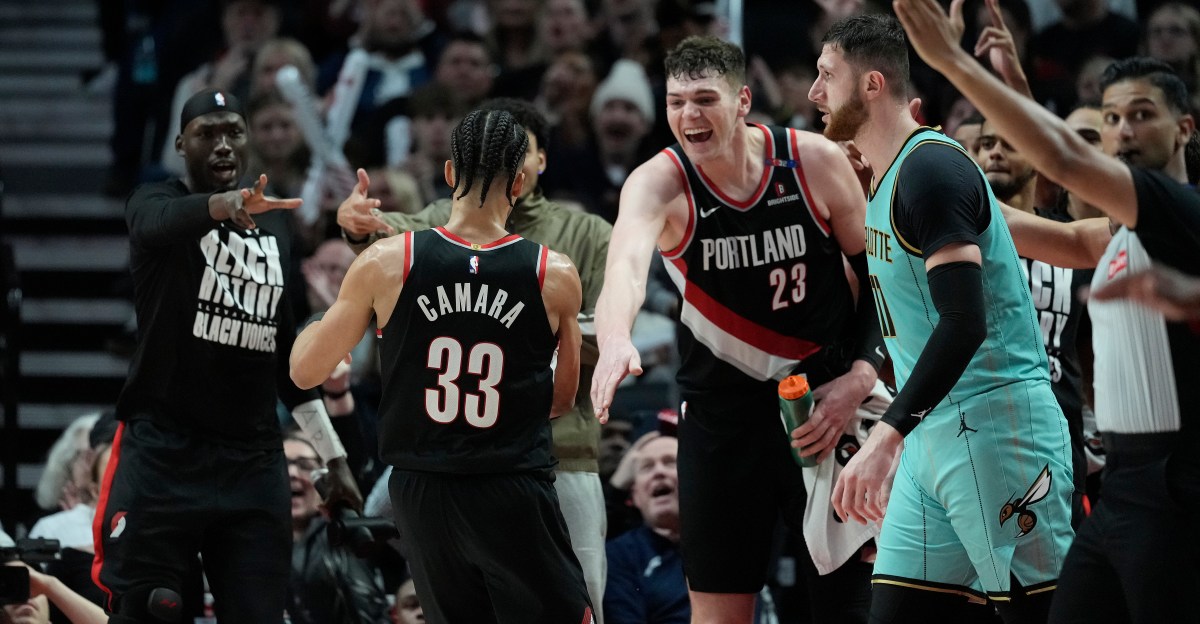Duck Dive: Rutgers Scarlet Knights Football 2025 Preview
Special thanks to Andrew Rice of On the Banks for joining me to discuss Rutgers’ roster on this week’s podcast:
:no_upscale()/cdn.vox-cdn.com/uploads/chorus_asset/file/25985186/Rutgers_offense.png)
Rutgers did get the improvement in offensive performance contemplated in my preview of last year’s team and for the reason identified – stability at and upgrade in the accuracy of the starting quarterback (although my model would have the Scarlet Knights at about 50th, not the wild jump to 34th that F+ advanced statistics has). The position had seemed to be cursed for nearly a decade in Piscataway, with no QB able to play a complete season for the seven years prior to 2023, and then finally getting a full season out of Gavin Wimsatt in the year before last but his accuracy was so poor that his NCAA passer rating was literally the lowest of any Power conference QB.
In 2024, Coach Schiano got the transfer of #16 QB A. Kaliakmanis from Minnesota, who’d been the starter there in 2023 and amazingly had set the second lowest passer rating (the move re-united him with Schiano’s playcaller, OC Ciarrocca, who’d recruited Kaliakmanis to Minnesota while Ciarrocca was there but had never coached him because he left for Rutgers while Tanner Morgan was still the QB in Minneapolis). Kaliakmanis has a powerful arm but never showed much touch or control on his passes and his accuracy and per-play success rate in Minnesota was pretty poor. At Rutgers, as predicted, these traits all continued to show themselves, but he stayed in position all year and he was an improvement over Wimsatt, so the offense took a step forward.
It’s also the case that Kaliakmanis gradually got more comfortable with a young group of wide receivers and there’s a steady incremental growth in the passing success rate over the course of the season. The overall number and each of the situational down & distance numbers get better towards the end of the year and all of them are about six to nine percentage points better for Kaliakmanis in 2024 at Rutgers than in 2023 at Minnesota, which given comparable talent and surrounding tools I think mostly reflects his own growth. It’s also straightforward to document statistically once garbage time is controlled for because none of the other underlying or fundamental stats change, it’s only success rate:
:no_upscale()/cdn.vox-cdn.com/uploads/chorus_asset/file/25985185/Rutgers_Kaliakmanis.png)
I could have continued listing constituent stats for this chart but they’re all identical over his career or any selected stretch of it: completion percentage is stuck at 54%, yards per reception is at about 11.9, yards per attempt at 6.46, TD:INT at 3:2, etc. On the podcast, Andrew made the argument that the bye week represented a substantial before-and-after break for Kaliakmanis, with the final five games of the season showing markedly better offensive output. That’s definitely true, but we also agreed there’s no particular “ah-ha” moment for the QB during the break, it’s just a convenient point for marking time in the gradual process of getting more comfortable locating successful passes to his WRs.
What’s notable over the course of Kaliakmanis’ career is that there’s always been a huge portion (around 45%) of throws that he just misses on, and that’s never changed at any point. For most of it, there’s been an equally huge portion of practically worthless completions for so few yards that they’re unsuccessful plays given the down & distance, and then a small handful of enormous throws on which the Gophers or Knights make practically all their yards. As time went on at Rutgers, that mix of completions got more practical – a good deal fewer useless short throws, a couple fewer giant bombs (bringing the net YPA down a bit), but a climb in productive chunk-yardage throws resulting in a climb in the success rate. That’s what it’s like to see a QB growing up.
Andrew predicted that growth to continue into 2025 with Kaliakmanis returning as the starter, as well as a more mature receiver corps with whom he’s developed some chemistry, and the trendlines look good for that. Rutgers was still underwater in most of the offensive metrics I track from charting but they’re on pace to break through by the end of the season, and the explosive passing potential to catch some opponents by surprise. The backup, low 4-star redshirt freshman #10 QB Surace, looked comfortable in the Spring game and by all accounts it’ll be his team when Kaliakmanis departs so there’s a plan in place, but clearly the starter staying healthy and avoiding a return of the cursed QB situation will be crucial.
For the last two seasons Rutgers’ rushing carry distribution and running back unit has looked very similar, but it’s facing a change in 2025. The lead back by a wide margin has been Kyle Monangai, who’s gotten over 230 meaningful carries for each of the last two years, and was just drafted in the 7th round by the Bears. In 2023, there was an argument to be made that Monangai was the Big Ten MVP in that he was the only productive player for Rutgers and the only one who could make anything of the nightmarish offensive line situation, with a 54% success rate and 5.1 adjusted YPC, while the other backs were all underwater and below 3 YPC.
But as Andrew and I discussed on the podcast, in 2024 the o-line solidified and those same backup RBs — #20 RB Benjamin, #27 RB Brown, and #21 RB Raymond (the last replacing Aaron Young) — saw their success rates and YPC numbers climb substantially, with Benjamin and Brown outperforming Monangai on a per-carry basis.
It looks like the productivity vs usage is upside down in 2024 – Monangai was overworked with the same stats as in 2023, Raymond as the new addition got the next most carries but he wasn’t ready for it because his stats are the lowest at 49% and 3.7 YPC (though still better than Young’s in 2023), while Benjamin and Brown should have had the load shared with them a lot more with great numbers near 60% and over 5 YPC. It seems like the staff didn’t recognize until it was too late that they didn’t need to use the same strategy of “only feed the one back who can get through the line” in 2024 and this was suboptimal, resulting in practically identical overall rushing stats between seasons.
In 2025 Rutgers has the opportunity to correct that, and according to Andrew they probably will. He told me he’s not expecting a “bell cow” approach this year but rather a much more even distribution, with the FAU transfer #5 RB Campbell probably getting the lead spot but closely followed by a mix of the returners Benjamin, Brown, and Raymond. Campbell’s numbers with the Owls look pretty good and there’s no reason to expect an irrational overwork situation like there was in 2024, so I think it’s reasonable to expect a climb in rushing performance, barring unforeseen offensive line problems.
Tight end utilization under Ciarrocca at both Rutgers and Minnesota in the past has been minimal, but Andrew pointed out that the challenge assessing this unit is that Kaliakmanis’ favorite target was a converted defensive lineman, #12 TE Fletcher, who got hurt halfway through the season and still lead the rest of the room by a wide margin. For the rest of the year we saw #11 TE Blake (although in at least one game he wore jersey #85 for reasons I haven’t been able to determine) almost exclusively in a blocking capacity. Fletcher’s numbers as a receiver aren’t great, a 38% success rate and 4.2 adjusted YPT, but Andrew was right that there was some chemistry building and this was the early part of the year when Kaliakmanis’ numbers with everybody were at their lowest so perhaps when Fletcher is back and the likely top TE they’ll improve.
They’ve taken a transfer, #18 TE Weber from Charlotte, who has comparable utilization to Fletcher but spread out over the entire season, and he’s Andrew’s bet for the second TE or competition with Fletcher for the top guy. The rest of the room is hard to assess since there’s so little use for it; #88 TE Higgins got some play in the Spring game but maybe that’s just because Fletcher, Blake, and senior #89 TE Konopka were all out.
Rutgers six wide receiver targets in 2024 could be split into three rough categories, and they’re returning one and losing one from each. The first category was the two top guys with about two-thirds of meaningful WR targets between them, outside receiver #9 WR Strong and inside receiver Dymere Miller; Strong returns while Miller has graduated. Both were fairly reliable, but their numbers weren’t much better than FBS average at 53% per-target success rate and 7.7 adjusted YPT.
The second category with about a fifth of targets were the very tall true freshman #8 WR Duff and the longtime inside receiver Christian Dremel, demoted to backup when Miller transferred in and finally graduated after walking on in 2019. These two were by far the most productive players on the team at a couple points above 60% success and 8.5 YPT for Duff and 10.2 YPT for Dremel … a rational distribution of targets would have gotten the ball to these two much more often and cut down on the top guys’ mediocre production substantially.
The last category comprised another true freshman in 2024, #2 WR Black who at 6’0” I saw both in the slot and at X-receiver, and a senior who’s now transferred out, Chris Long; these two got the last 15% of meaningful WR targets. Long’s numbers aren’t very good at all, but Black’s are intriguing – underwater at 47% success (Andrew and I discussed something of a drops issue) but with a pretty impressive 8.6 YPT all the same, meaning that he was getting so many yards on the balls he’d actually catch that it was more than making up for how hit-or-miss he was. If Black could become more surehanded as a sophomore, he might really take off.
As I see it, at all three of those categories Rutgers is returning the more promising of the two, if they had to pick, so they’re set up with a reliable if unspectacular outside receiver with a connection to the QB in Strong, an even bigger and more productive outside guy who’s overdue for a target increase in Duff, and a swing receiver who’s showed a lot of promise and just needs to get more reliable in Black (which can describe the QB as well). The spot they needed to fill was the slot, and I think they addressed it well through the portal with #0 WR Sheffield, who was statistically very productive last year at North Texas and I observed in 2023 coming out of Juco with Wazzu looking good before his season got cut short.
That lineup looks pretty appealing and there’s some built-up history with Kaliakmanis so I think Andrew is right to anticipate further growth in the passing game here. I think the downside looks like depth in case something goes wrong. The only other receiver who showed out in Spring was #1 WR F. Toure, a junior with no playing time but who Andrew told me the staff has called the most improved player this offseason. There are only two other returners in the room who are both inexperienced upperclassmen and I’m concerned are unplayable, and while the team took five prep recruits some of whom had some nice outings in the Spring game — a good sign for the future — that’s not the kind of chemistry that Kaliakmanis has shown he needs.
The current iteration of the Rutgers offensive line has its origins together in 2023. In that year, several injuries as well as unsatisfactory play shuffled around new and returning starters with guys off the bench, and four of the linemen who’d go on to become the 2024 and projected 2025 starters were playing together at that time. The 2023 season was pretty messy as a result of the constant shifts and at least one future starter not being ready for the job, but it set the table for the solidification in 2024 – despite another injury and a position shift; it was a comparatively light amount of trouble — and what looks like a pretty battle-tested group of returners with good interior backups for 2025.
The four returning starters are #65 LG Felter, #59 C G. Zilinskas, #69 RG Asamoah, and #56 RT Needham. Felter took a knee injury a month into the season and was replaced by a rotation of seniors #54 OL T. White (then wearing #63) and #76 OL Chin. For the last several games, Needham got converted to a what could be thought of as a big blocking TE or sixth OL in jumbo sets, while White took over at RT and Chin had the LG job full time.
Felter and Chin were both being held out of the Spring game with injuries. Andrew told me that Chin was an unknown issue, but Felter is projected to be back healthy for the Fall. Even if it takes him a while to get fully back to 100%, they’ve got depth at guard with three more upperclassmen playing with the ones and twos in the Spring game in #55 OG Oliveira, #61 OG Stinette, and #71 OG Stone.
Longtime starting left tackle Hollin Pierce, who by far had the best grades on my tally sheet, and Reggie Sutton, who in 2022 was the starting right tackle but suffered a severe leg injury and never got back to 100%, have both graduated. The three transfers out of the room are all older guys who might have been depth at tackle: Shedrick Rhodes, Dominic Rivera, and Mozell Williams. Andrew and I agreed this is the biggest issue that the line faces, because they only had one guy able to play tackle besides Needham and White in the Spring game who was redshirt freshman #58 OT Kadow, forced into action for both teams. After Andrew and I recorded, they took the transfer of Zach Aamland, an OT from Illinois returning home to New Jersey but who hasn’t played in two years in Champaign. If they have any sort of problem at tackle they’ll be reliant on a very green replacement.
Assuming that White or Needham can play left tackle (we’ve only seen either at right), then everyone else should keep their jobs and it’ll be a set lineup made up entirely of homegrown three-year starters, give or take. Their blocking grades on my tally sheet were pretty awful in 2023, particularly Zilinskas and Asamoah, and the fact that neither Needham nor Felter have finished a full season in two years is concerning as well, but this group has overall demonstrated growth in outcomes so far and the conditions are ripe for more of it in 2025.
:no_upscale()/cdn.vox-cdn.com/uploads/chorus_asset/file/25985184/Rutgers_defense.png)
Rutgers had been on very steady upward climb in their overall defensive quality during Schiano’s second stint through the end of 2023, gaining about 15 ranks in F+ defense each year since taking over again in 2020. Beyond competent coaching and a sound scheme, the keys to this were their developmental pipeline in the front and finding underrated values in the defensive backfield. In my 2024 preview I thought they had a pretty good chance of continuing their ascent into perhaps a top 25 defense since they’d been working on a number of those developmental options for a while but they’d need to find a way to reverse a concerning backslide in rush efficiency defense and address a significant cornerback loss to the NFL.
It turns out neither of those things happened and the defense fell back into the 60s, and the concern for 2025 is that the staff’s faith in their internal development may be shaken as they’re now going much more heavily to the portal – nine defensive transfers this cycle compared to one last time around. They’ll be doing it without Schiano’s longtime coordinator, Joe Harasymiak, who’s now the head coach at UMass, They’ve rehired Robb Smith to be the playcaller, who’s bounced around to a lot of different jobs including a couple years at Rutgers a while ago and was most recently an analyst at Penn State (Andrew seemed unenthusiastic about him, although he helped them bounce back in the covid season from the Chris Ash disaster) and James Madison’s Zach Sparber to be the LB coach and co-DC who’s something of an up-and-comer.
I spent a good deal of last year’s preview laying out the history of the defensive line and trying to tease out if it was that unit or the linebackers which was responsible for the three-year slide in rush defense performance. I think that work turned out to be for naught because both groups suffered unfortunate setbacks in 2024 and rush defense went from bad to worse – the tackles didn’t really get the quality help they needed from the one transfer they took that cycle while the ends lost the one truly effective lineman who’d been playing a hybrid role to be a full-time tackle, and both of the starting linebackers had injuries of varying severity. These aren’t temporary issues, unfortunately, as the top players at tackle and end depart and while both the starting linebackers are back to full health, one was denied an extra year of eligibility and the other made a last-minute decision to transfer out. The front returns a significant number of bodies in each unit, but since these are mostly the guys who fell short last year there’s a big question looming about how well the internal development operation is still working.
Last year the defensive tackles had four-year starter Kyonte Hamilton, who was good enough that he’d play at all positions along the line during his time at Rutgers including end and graded out by far the best on my tally sheet. He was drafted by the Texans in the 7th round. The other four in the rotation were #55 DT Angoy, #96 DT Griffin, Troy Rainey, and Malcolm Ray. The first three of those first started getting reps as backups in 2021 as freshmen and have been playing as long as Hamilton has, but have simply never come close to performing at his level. They took the fourth in that group, Ray, as a transfer from Florida State last year I think in acknowledgement of the issue, and while Ray jumped ahead of the rest to be a starter next to Hamilton, his grades weren’t a whole lot better than the also-rans. Rainey and Ray have graduated, while Angoy and Griffin return for their final season in 2025.
I think Angoy and Griffin have spots in the primary rotation, despite reservations about their effectiveness, because Andrew’s comments here about Schiano’s preference for sticking with guys through to their last season of eligibility strike me as accurate. I also think that one of the transfers they got, #0 DT Blue-Eli from USF (before that he was a Juco who went to TCU, he got an extra year from the Pavia waiver) is going to be in the primary rotation because he looked to be the biggest and most effective tackle in the Spring game and he’s certainly very experienced.
Past those three, sorting out the rest of the tackles gets pretty tricky. There are two promising prep recruits but Andrew and I doubt they’ll play in 2025. There are two more returners, but neither are ideal: one is #95 DT Hughes who’s a 2021 guy just like Angoy, Griffin, and Hamilton, but he’s gotten practically zero playing time in four years and I have my doubts he’s playable, while the other is #90 DL Gnago, a low 3-star redshirt freshman who was all over the Spring game with the ones and the twos at a tackle position but is built like an end (he’s listed at 260 lbs and I think he might have been holding his bookbag when they weighed him), Andrew thinks he might play both spots which I could see on certain 3rd down packages but I can’t see him on the inside being viable for standard downs.
The same is basically true for a late transfer from Kent State, Oliver Billotte, who I’ve seen play tackle for his old squad when charting them against Big Ten teams but is built like an end at this level (Andrew said he’s worked with Rutgers’ DT coach Ferrell before, so maybe he’ll also be a hybrid). I also didn’t get to see the third transfer here, JMU’s #92 DL DeNgohe, as he was being held out of the Spring game. I think he’s a tackle and Andrew eventually endorsed that though he said he hadn’t heard much about him, but without getting eyes on him it’s hard to say.
Despite the hesitation, through process of elimination I think DeNgohe at 295 lbs and prior starting experience under Sparber is the only logical choice for the fourth tackle in the rotation. So that’s two tackles in Angoy and Griffin I haven’t been wild about for four years in which the unit has slid in performance each time out, a journeyman transfer on his fourth school in seven years as their best shot for quality play, and another transfer I’m guessing at through logical construction. Beyond that rotation are two guys who should be ends, a senior who’s never played, and true freshmen for depth in case something goes wrong. I can’t say I’m sanguine for the prospects of arresting the slide, much less reversing it.
There’s a considerable amount of movement in the defensive end room which is going to be relevant for 2026 — the developmental pipeline seemed to be disrupted here as they played three walk-ons as backups and converted tight ends both into and out of this unit, while three of the five prep recruits from last cycle have transferred out and a fourth, Gnago, is moonlighting at tackle — but that churn probably won’t have an immediate impact on the 2025 production as the primary four seem to be set and each on their final year.
They return #14 DE Thompson and #8 DE J. Walker from last year’s rotation, and got veteran transfers #99 DE O’Neill from JMU and #94 DE Weaver from Ohio. Nobody else in the room comes close to their seniority or prior production so I doubt there’ll be any real competition, just a question of who starts and who’s behind them. Andrew’s bet is it’s O’Neill and Walker, followed by Thompson and Weaver; I think he’s completely correct about O’Neill but I could see Walker getting a challenge from one of the others, since he was the converted tight end last year it was amazing to me that he broke through at all.
Last year was something of a disappointment for the ends. Aaron Lewis was on his fourth straight year of starting but it wasn’t his best, unfortunately, and Wesley Bailey was physically unable to play more than four games and has now transferred out; those two were previous havoc stat leaders in earlier iterations of Rutgers’ defense. I think the falloff in explosive pass defense is mostly about the back end personnel, but a non-trivial amount has to do with a less effective pass rush in 2024 that I’m sure they’re hoping to correct. We’ll just have to wait and see if the transfers can fill that void, and if in the future they can get the developmental pipeline working again.
Rutgers got pretty awful injury news for both their starting linebackers in the 2024 offseason – Tyreem Powell tore his Achilles while he was rehabbing his shoulder that caused him to miss several games in 2023, and Mohamed Toure tore his ACL. Powell returned to action three weeks later than hoped and it seemed clear he was never really at the full speed I’d seen him play at in 2022 and 2023. Toure missed the entire season, the second one he’d missed at Rutgers since he also couldn’t play in 2022. Powell has formally run out of eligibility while Toure got in the portal just before the 2025 Spring game.
Former walk-on #28 LB Djabome stepped into the absence and wracked up over 100 tackles during the season; he returns and doubtlessly has a starting job back. Andrew said the most likely second starter is #2 LB M. Walker, which makes sense as he got the most backup play last year, is the oldest in the unit as a 2022 recruit, and is the highest talent on paper as a former low 4-star, though how he’ll actually perform is still something of an unknown.
The only other backer who’s seen the field is #6 LB Wright (wearing #11 last year), who was a mid 3-star redshirt freshman last year and got a bit of backup play but I didn’t get enough meaningful tape on to evaluate, and I didn’t spot in the 2025 Spring game (Djabome was also being held out but Andrew said that was just to preserve him from some minor injury, while Wright was a mystery). There are eight freshmen in this room with zero experience, three from the 2024 and five from the 2025 cycles, while this is the only defensive unit with no one out of the portal. So apparently the staff’s faith in the linebacker development remains strong, but I’m at a loss as to who the actual playable depth is behind the starters. On the podcast, Andrew basically listed the entire room as potential second-stringers or even giving Walker a challenge for a starting spot next to Djabome; I get the feeling we’re going to have to wait and see who takes the field to find out.
The secondary is facing an almost total reset in 2025. The three starting safeties in the nickel structure who had played virtually every snap since 2023 (and two of them reach as far back as 2021 as backups) are all graduating at once, those are Flip Dixon, Desmond Igbinosun, and Shaquan Loyal. It’s a similar story for the cornerback Robert Longerbeam, who’s been playing since 2021 and I don’t remember leaving the field on any meaningful rep in the last two years, and has now been drafted in the 6th by the Ravens. Longerbeam had played opposite of Max Melton up until 2023, who as Andrew aptly noted truly was a lockdown corner (and was a charming presence at the 2025 Spring game) and then was drafted in the 2nd by the Cardinals.
In 2024 Rutgers tried to replace Melton by splitting reps between Eric Rogers and #3 CB Mascoe; it was somewhat expectedly a step down in performance (although it took some of the pressure off Longerbeam, since during the Melton era opposing QBs picked on him much more) and Rutgers’ explosive passing defense fell off. Rogers has graduated and Mascoe is the only secondary member with meaningful play experience who returns.
As Andrew and I discussed, Rutgers isn’t hurting for bodies in their secondary – excluding freshmen and transfers they have 13 returners, with the new guys added it rises to 20 – and Schiano has a well deserved reputation for finding and developing undervalued defensive backs and has a higher than expected rate of NFL placements for these units given the recruiting profile, so I don’t think the staff’s choices for all the new starters in 2025 will be constrained or foolish. But when it comes to actually naming names, as we said on the podcast, it’d just be guessing – we have very little to go on here for differentiating guys.
In the spirit of guessing, I will put my markers on: true sophomore #5 DB Sanders at free safety since he got a lot of garbage time run, had the spot in the Spring game and looked well built for it, and is the most talented on paper in the room as a low 4-star; UNLV transfer (and there’s a longer history, Andrew relayed an interesting story of his court battle for eligibility) #9 DB Elad at boundary safety since he looked like the hardest hitter on the field during Spring and could really run the alley; and Penn State transfer #7 DB Miller at nickel as I’m choosing to believe that he only graded out poorly in Happy Valley because of the Penn State DB Black Hole and that a change of scenery will do the bluechip well. For corners I’ll go with Mascoe again and #21 CB Salaam since I think he’s earned it after a wild career converting from a running back, although this one I’m the least sure of and I think #27 CB Clawges is a better pick from a pure physical perspective, it’s just that he’s a couple years younger.
The wild cards here are how many transfers that Rutgers have taken. Besides Elad and Miller, who I think will win jobs, they’ve also added two highly accomplished transfers, #10 CB Henderson from Marshall and just recently Chris Joines from the FCS ranks who has more tackles than anyone on the team except Djabome and Elad. I really have no idea how they’ll figure into things in the immediate term, other than to say that they clearly know how to play football so depth shouldn’t be a problem, but it’s something of a head scratcher for a program that’s so oriented around patient defensive development that was loaded up with returning guys they were ostensibly working on.
Share this content:














Post Comment